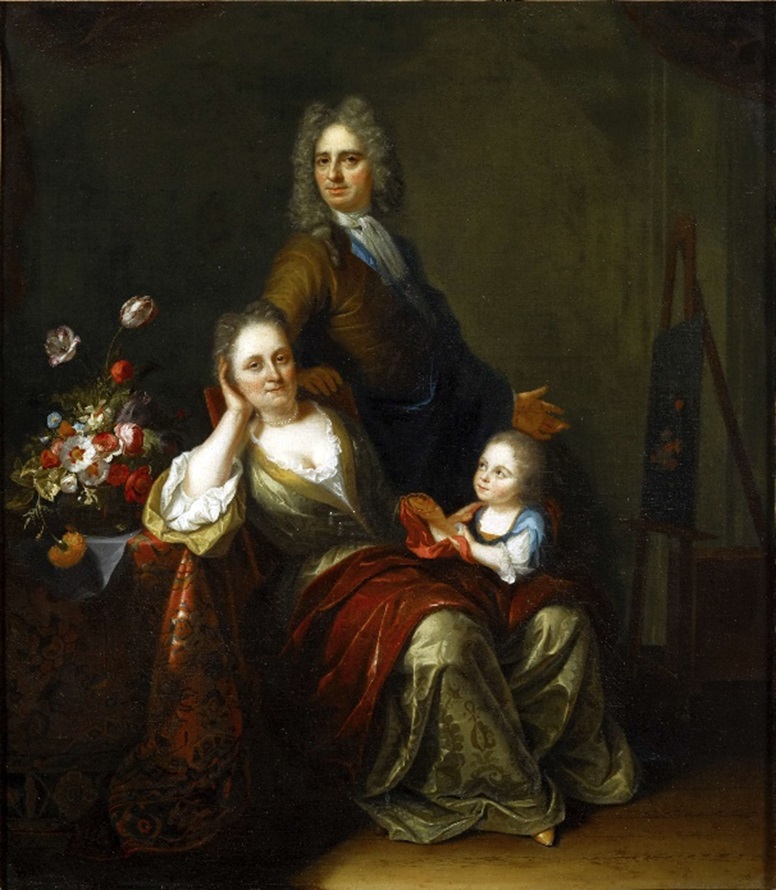Probably the most extraordinary and successful Dutch artist celebrates her 360th birthday on 3 June: Rachel Ruysch (1664-1750). Her magnificent, deceptively realistic floral still lifes with exotic plants and fruits, butterflies and insects were already considered sought-after and expensive collector’s items during her lifetime. Demand was so great that the Amsterdam painter could only afford to produce a few pieces a year.
Image above: Rachel Ruysch (1664-1750), Still Life with Roses, Tulips and Sunflower, 1710 Oil on canvas, 88.9 × 71.1 cm, inventory number L1317, The National Gallery, London On loan from the collection of Janice and Brian Capstick © Private Collection
As the daughter of the renowned professor of anatomy and botany, Frederik Ruysch, the first female member of the Confrerie Pictura, court painter in Düsseldorf, lottery winner and mother of eleven children, she was an exceptional figure of her time. Nevertheless, her life and work have hardly been researched to date. The Alte Pinakothek is therefore dedicating the world’s first retrospective to her from 26 November 2024: the exhibition ‘Rachel Ruysch – Nature into Art’ takes an in-depth look at the artist’s life, her many years of productive work and her enduring fame. It also focuses on her artistic and intellectual environment. In particular, the connections between her work and the great scientific questions of the 17th and 18th centuries will be traced. The famous collection of scientific specimens by her father, Frederik Ruysch, is likely to have been a key source of inspiration for her artistic work.
Rachel Ruysch worked in Amsterdam all her life. At the age of around 15, she was apprenticed there to the leading still life painter Willem van Aelst. Inspired by the works of her mainly male artist colleagues, she quickly made a name for herself and in 1701 became the first female member of the renowned Confrerie Pictura artists’ association in The Hague. In the first decade of the 18th century, she painted large, sophisticated flower bouquets that established her reputation as one of the leading flower still life painters. In 1708, she was appointed court painter to Elector Johann Wilhelm von der Pfalz in Düsseldorf and remained in his service until his death in 1716. During this time, she regularly combined magnificent bouquets of flowers with detailed fruit pieces teeming with insects. In the last decade of her almost seventy-year career, she virtually reinvented herself once again by adapting her style to the current taste of French Rococo with a light colour palette and a brighter background. Many of these late paintings bear not only her signature and the date of the work, but also her age. She was evidently justifiably proud of the fact that she was still completing high-class works at the age of 80.
This major international exhibition on Rachel Ruysch brings together her most important works from European and US public and private collections, including a number of new discoveries. In addition, there are portraits of Rachel Ruysch, her family and her father as well as books, prints, drawings and scientific exhibits. An interdisciplinary collaboration with botanists, zoologists and historians of science will place her work in the context of the scientific discoveries and debates of her time.

The show sheds new light on the connections between art and science at a time of scientific upheaval and on the role of women in the exploration of nature. The relationship between Rachel Ruysch and other renowned female still life painters and scientists is also examined.
-She also included the tradition of flower painting on which she built. The juxtaposition with paintings by her teacher Willem van Aelst, her contemporaries Jan Davidsz. de Heem, Otto Marseus van Schrieck and Abraham Mignon as well as other talented artists such as her sister Anna Ruysch, Maria van Oosterwijck and Alida Withoos illustrates her influences, her love of experimentation and her innovative strength.
With a selection of her best works, the exhibition ‘Rachel Ruysch – Nature into Art’ will for the first time present the different creative phases and the variety of pictorial themes, reunite separate pairs of paintings and demonstrate the outstanding quality of the artist in the context of her contemporaries. At the same time, the exhibition and research project is dedicated to the artistic and intellectual environment in which she lived and worked.
With a total of over 200 exhibits, including around 80 paintings from national and international lenders and over a hundred loans from state museums and institutions in Bavaria, this exhibition is exceptional for the Alte Pinakothek.
The exhibition is organised by the Bayerische Staatsgemäldesammlungen – Alte Pinakothek, Munich, the Toledo Museum of Art and the Museum of Fine Arts, Boston. The results of the long-term joint and interdisciplinary research project will be presented in a scholarly monograph accompanying the exhibition.
The exhibition is under the patronage of Princess Sophie of Bavaria.
Further information about the exhibition
www.pinakothek.de/nature-into-art
Toledo Museum of Art, Ohio | 13 April 2025 – 27 July 2025
Museum of Fine Arts, Boston | 23 August 2025 – 07 December 2025
WHEN?
Exhibition dates:
Tuesday, 26 November until Sunday, 16 March 2025
Opening hours:
Daily except Monday from 10.00-18.00
Tuesdays and Wednesdays from 10.00-20.00
WHERE?
Old Pinakothek
Barer Str. 27
80333 Munich
COST?
Permanent collection 9 €
6 € reduced
Sundays 1 € each






